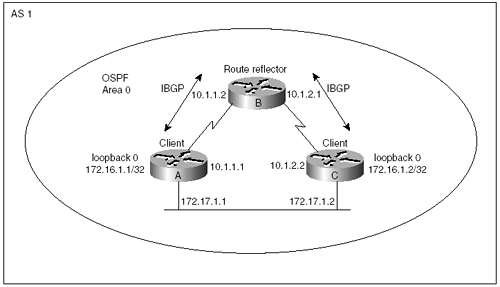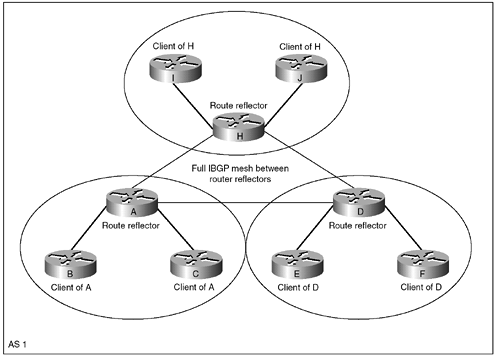8-27 neighbor ip-address peer-group-name route-reflector-client
| < Free Open Study > |
8-27 neighbor { ip-address peer- group - name } route-reflector-clientSyntax Description:
Purpose: IBGP neighbors do not propagate routing information learned from one IBGP neighbor to another IBGP neighbor. Therefore, if you are running IBGP, every IBGP speaker must have a connection to every other IBGP speaker in the AS. This becomes a scaling problem as the number of IBGP speakers increases . The number of IBGP connections for n speakers is ( n ( n -1))/2. Table 8-1 lists the number of connections needed for 2 to 10 IBGP speakers. Table 8-1. IBGP Connections Needed for a Full Mesh
A route reflector is one technique to overcome the scaling issue with IBGP. One or more routers serve as a route reflector, and other routers are clients to the route reflector. Route reflectors reflect routes learned from a route reflector client to the other clients . With one route reflector, the number of logical connections needed for n IBGP speakers is n -1. Cisco IOS Software Release: 10.0. Peer group support was added in Release 11.0. Configuration Example 1: Single Route ReflectorAssume that the network in Figure 8-27 requires IBGP for the exchange of routing information. Without a route reflector, we would need three BGP neighbor connections. We can reduce the number of BGP connections to two by using a single route reflector. Figure 8-27. Route Reflector Router A interface Loopback0 ip address 172.16.1.1 255.255.255.255 ! interface Ethernet0 ip address 172.17.1.1 255.255.255.0 ! interface Serial0 ip address 10.1.1.1 255.255.255.252 ! router ospf 1 network 10.0.0.0 0.255.255.255 area 0 network 172.16.0.0 0.0.255.255 area 0 network 172.17.0.0 0.0.255.255 area 0 ! router bgp 1 neighbor 172.16.1.3 remote-as 1 neighbor 172.16.1.3 update-source Loopback0 __________________________________________________________________________ Router B interface Loopback0 ip address 172.16.1.3 255.255.255.0 ! interface Serial0 ip address 10.1.1.2 255.255.255.252 clockrate 64000 ! interface Serial1 ip address 10.1.2.1 255.255.255.252 clockrate 64000 ! router ospf 1 network 10.0.0.0 0.255.255.255 area 0 network 172.16.0.0 0.0.255.255 area 0 ! router bgp 1 neighbor 172.16.1.1 remote-as 1 neighbor 172.16.1.1 update-source Loopback0 neighbor 172.16.1.1 route-reflector-client neighbor 172.16.1.2 remote-as 1 neighbor 172.16.1.2 update-source Loopback0 neighbor 172.16.1.2 route-reflector-client __________________________________________________________________________ Router C interface Loopback0 ip address 172.16.1.2 255.255.255.255 ! interface Ethernet0 ip address 172.17.1.2 255.255.255.0 ! interface Serial0 ip address 10.1.2.2 255.255.255.252 ! router ospf 1 network 10.0.0.0 0.255.255.255 area 0 network 172.16.0.0 0.0.255.255 area 0 network 172.17.0.0 0.0.255.255 area 0 ! router bgp 1 neighbor 172.16.1.3 remote-as 1 neighbor 172.16.1.3 update-source Loopback0 Notice that only the route reflector needs additional configuration. Loopback addresses were used in this configuration. See section 8-33 for a discussion of IBGP and loopback addresses. VerificationVerify that the IBGP sessions are being established with the route reflector by examining the IBGP neighbors on Router B: rtrB# BGP neighbor is 172.16.1.1, remote AS 1, internal link Index 1, Offset 0, Mask 0x2 Route-Reflector Client BGP version 4, remote router ID 172.16.1.1 BGP state = Established, table version = 3, up for 00:28:24 Last read 00:00:26, hold time is 180, keepalive interval is 60 seconds Minimum time between advertisement runs is 5 seconds Received 31 messages, 0 notifications, 0 in queue Sent 31 messages, 0 notifications, 0 in queue Prefix advertised 0, suppressed 0, withdrawn 0 Connections established 1; dropped 0 Last reset 00:28:34, due to RR client config change 0 accepted prefixes consume 0 bytes 0 history paths consume 0 bytes Connection state is ESTAB, I/O status: 1, unread input bytes: 0 Local host: 172.16.1.3, Local port: 11026 Foreign host: 172.16.1.1, Foreign port: 179 BGP neighbor is 172.16.1.2, remote AS 1, internal link Index 2, Offset 0, Mask 0x4 Route-Reflector Client BGP version 4, remote router ID 172.16.1.2 BGP state = Established, table version = 3, up for 00:28:21 Last read 00:00:22, hold time is 180, keepalive interval is 60 seconds Minimum time between advertisement runs is 5 seconds Received 31 messages, 0 notifications, 0 in queue Sent 31 messages, 0 notifications, 0 in queue Prefix advertised 0, suppressed 0, withdrawn 0 Connections established 1; dropped 0 Last reset 00:28:33, due to RR client config change 0 accepted prefixes consume 0 bytes 0 history paths consume 0 bytes Connection state is ESTAB, I/O status: 1, unread input bytes: 0 Local host: 172.16.1.3, Local port: 11027 Foreign host: 172.16.1.2, Foreign port: 179 Configuration Example 2: Multiple Route ReflectorsMultiple route reflectors can be used in an AS to further scale the network. Figure 8-28 has nine routers. Three of themRouters A, D, and Hare acting as route reflectors. Router A has route reflector clients B and C, Router D has route reflector clients E and F, and Router H has route reflector clients I and J. A full IBGP mesh is required between Routers A, D, and H, as shown in the following configurations. Figure 8-28. Multiple Route Reflectors Router A router bgp 1 neighbor (IP address for Router B) remote-as 1 neighbor (IP address for Router B) route-reflector-client neighbor (IP address for Router C) remote-as 1 neighbor (IP address for Router C) route-reflector-client neighbor (IP address for Router D) remote-as 1 neighbor (IP address for Router H) remote-as 1 __________________________________________________________________________ Router B router bgp 1 neighbor (IP address for Router A) remote-as 1 __________________________________________________________________________ Router C router bgp 1 neighbor (IP address for Router A) remote-as 1 __________________________________________________________________________ Router D router bgp 1 neighbor (IP address for Router E) remote-as 1 neighbor (IP address for Router E) route-reflector-client neighbor (IP address for Router F) remote-as 1 neighbor (IP address for Router F) route-reflector-client neighbor (IP address for Router A) remote-as 1 neighbor (IP address for Router H) remote-as 1 __________________________________________________________________________ Router E router bgp 1 neighbor (IP address for Router D) remote-as 1 __________________________________________________________________________ Router F router bgp 1 neighbor (IP address for Router D) remote-as 1 __________________________________________________________________________ Router H router bgp 1 neighbor (IP address for Router I) remote-as 1 neighbor (IP address for Router I) route-reflector-client neighbor (IP address for Router J) remote-as 1 neighbor (IP address for Router J) route-reflector-client neighbor (IP address for Router A) remote-as 1 neighbor (IP address for Router D) remote-as 1 __________________________________________________________________________ Router I router bgp 1 neighbor (IP address for Router H) remote-as 1 _________________________________________________________________________ Router J router bgp 1 neighbor (IP address for Router H) remote-as 1 There are three clusters of routers. The first cluster contains Routers A, B, and C. The second cluster contains Routers D, E, and F. The third cluster contains Routers H, I, and J. Each cluster is configured with one route reflector and two clients in the same fashion as Configuration Example 1. The route reflectors need to be configured using a full IBGP mesh using normal IBGP connections or a nonclient peer connection. Route reflectors advertise routes based on the following rules:
Troubleshooting
|
| < Free Open Study > |
EAN: 2147483647
Pages: 300

